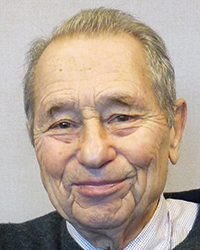Cover Story
Firm Foundations

What Are the Most-Replicated Studies in Psychological Science?
Amid ongoing efforts to improve the reproducibility of psychological science, it’s easy to lose sight of the findings that remain sturdy decades after they were first reported. The Observer asked a random sample of APS leaders, of various career levels and nationalities, to tell us what they consider to be the most replicated or durable finding in psychological science. You might expect the responses to center on classics like Pavlov’s conditioning experiments with dogs, the Asch social conformity experiments, or the Loftus and Palmer car crash study on memory distortion. But contributors identified a breadth of other work that they believe serve as a reliable foundation for psychological research. APS Board Treasurer Roberta “Bobby” Klatzky, who has written and spoken considerably about the replicability issue, provides an introduction to this special section. We invite readers to share their own thoughts about findings that have stood strong over time. Write us at [email protected].
 Roberta “Bobby” Klatzky
Roberta “Bobby” Klatzky
Carnegie Mellon University
Deep in the wilderness of psychology’s replication crisis, my voice has occasionally been heard, pithily uttering, “Huh?” Apparently, I am not alone: This special feature in the Observer highlights fundamental and reliable contributions of our science that were identified by some APS members.
In my own corner of the psychological science woodlands, the trees seem tall and strong, and it’s a daunting task to single out findings that merit special mention. I will frame a few as general themes:
(1) Across the senses, human perceptual sensitivity encompasses only a range of the corresponding physical variation and is far from constant across that range. For example, humans hear sounds between roughly 20 Hz and 20 kHz, with a sweet spot around 3 kHz. The human high-frequency hearing limit is well below the bat’s, which is one reason phones don’t have a bat-sound ring tone .
(2) There is a tight coupling between perceptually based representations and action. People act toward the products of perception. Returning to the sense of hearing for an example, people tend to misperceive sounds as nearer than their actual source locations, so in the absence of corrective feedback, they will fall short when walking to auditory targets. Conversely, people act to create products of perception. Humans (and dexterous animals) manually explore objects in stereotyped ways that depend on the perceptual goal, for example, by using lateral rubbing motions when judging the roughness of a surface.
(3) Perception demonstrates limited capacity, more so as we move from sensing the world to representing its contents. The famous cocktail-party phenomenon shows we can’t decode two speakers at once, but we can detect abrupt pitch changes in an unmonitored auditory stream. When people search for a target in space, their detection times tend to increase linearly with the number of similar distractors, a capacity-driven regularity that emerges in touch as well as vision.
I write about themes here, rather than empirical “laws,” because the data from any experiment will vary depending on the particulars. Through the following observations, I’d like to emphasize that dependence on the particulars does not mean failure to replicate.
(1) Hypothesis testing is not necessarily the point of psychological science, nor is replication always an issue. Psychophysical judgments are commonly used to make fundamental measurements, as when we “perception types” assess absolute or difference thresholds (minimal stimulation to be detected or differentiated) or quantify perceptual sensitivity to a range of variation across some physical scale. These measurements not only characterize the human sensory apparatus, but they are also used to track the course of developmental change or to detect deviations that signal accident or disease. What’s important here is not replication, but rather the precision of measurement and the normative range of variation for a particular population.
(2) Sometimes, variation is not just part of the story; it’s centrally important. Let’s take the two-point acuity threshold for touch. Measure it on the fingertips, and you’ll find something on the order of a millimeter. Asking people whether a probe feels like one point versus two may lead to a different measurement than detecting a gap in a continuous edge. This outcome is not a failure to replicate; it points to basic differences in these perceptually based decision processes. If we stipulate a particular type of measurement, such as gap detection, we will find that the fingertips permit smaller gaps to be discerned than does the back. Is this a failure to replicate? No; it reflects the distribution of sensory receptors. The frequency-dependent sensitivity in the auditory system mentioned above, along with the systematic tendencies found in exploratory touch, can also be traced to the receptor level.
(3) Value can also be found in those fluctuations we treat as statistical noise. Perceptual systems are variable. Measure the same person twice, in the same way, and more likely than not, you will get a different value (assuming your measure is fine-grained enough to detect a difference). Compare two people, and differences will likely be greater. I’m a big fan of getting down into the twigs of the data to look at the noise. In early work with Jack Loomis and collaborators, we tracked the point-to-point progress of blindfolded sighted, congenitally blind, and adventitiously blind subjects as they tried to make their way back to the origin of a triangle after being led along the initial two legs. When we graphically reported all the trajectories, we showed clearly that people coming from the same drop-off point ended up at considerably different locations. The magnitude of these interpersonal variations, which proved unrelated to visual capability, was part of our story, as were the systematic (and statistically confirmed) effects of the pathway itself. When it comes to getting into the twigs, APS Fellow Jeremy Wolfe set the bar high (or is it low?) in 1998 when he reported distributions of slopes from approximately a million trials of visual search. I’ll leave you to read his paper, but it’s clear that search is both a random and principled process.
There’s a lot more I could say about replication, like pointing out that within-subject designs make every participant a replicate, or that some level of nonreplication is actually predicted for phenomena predicated on a series of random processes. (My colleague J. David Creswell and I discuss this point in a 2014 article in Perspectives on Psychological Science.) These woods are lovely, dark, and deep, but I will make way for others to explore them in this feature.
References
Klatzky, R. L., & Creswell, J. D. (2014). An inter-sensory interaction account of priming effects — and their absence. Perspectives on Psychological Science, 9, 40–48.
Loomis, J., Klatzky, R. L., Golledge, R. G., Cicinelli, J. G., Pellegrino, J. W., & Fry, P. A. (1993). Non-visual navigation by blind and sighted: Assessment of path integration ability. Journal of Experimental Psychology: General, 122, 73–91.
Wolfe, J. M. (1998). What can 1 million trials tell us about visual search? Psychological Science, 9, 33–39.
 Terry Au
Terry Au
University of Hong Kong
In developmental psychology, the most-replicated finding is preschool children’s failure to pass Jean Piaget’s classical conservation tasks, designed to measure logical thinking. Conservation refers to the ability to understand that a quantity remains the same even when it changes shape or form. In one of the most famous of the conservation experiments, a child watches liquid being poured into two short beakers until both contain an equal amount. Then the experimenter takes a tall, thin beaker and fills it with water from one of the short beakers. The child is then asked whether the tall beaker and the other short beaker contain the same amount of liquid. Most children under the age of 6 say the tall container holds the most liquid. In short, they’re swayed by the height of the liquid in the tall beaker, ignoring all other dimensions. Piaget’s findings showed how children in the preoperational stage of development (ages 2–5) have yet to develop the ability to see an object’s properties as conserved or invariant as it undergoes transformation. The results from these experiments were so puzzling and seemed contrary to preschool children’s everyday competence that it unleashed a few decades of “early competence” research on preschool children and even infants. The findings of early competence research helped us understand better the starting (or near starting) point of cognitive development.
References
Piaget, J. (1954). The child’s conception of number. Journal of Consulting Psychology, 18(1), 76.
Piaget, J. (1968). Quantification, conservation, and nativism. Science, 162, 976-979.
 Moshe Bar
Moshe Bar
Bar-Ilan University, Israel
There is one finding that has been serving me most reliably since my graduate school days, to eternity, and it is priming. Sometimes referred to as a paradigm, the phenomenon of priming is a finding, and a deep one in what it reflects about the underlying operation of brain and behavior. It is so replicable and omnipresent that it has become almost a household name that does not require an introduction. In the domain of object recognition, for example, where I had encountered it first, it means that when you see an object that you have seen before you would recognize it faster, and often more accurately, than on your first exposure to that object. This is repetition priming, and it is readily evident in almost all types of repeating material. On the one hand, this basic finding facilitated our thinking about learning, (implicit) memory, efficient neuronal coding, and much more. On the other hand, the robustness of priming allowed using it as a powerful flashlight with which to explore the nature of representations. Priming was then used to examine semantic and contextual associations, as well as other conceptual relations in language and vision research. By now, the extent of using priming spans from showing that we can also learn from subliminal visual presentations, to using such repetition-based shortening of reaction time for lie-detection. It has helped resolve debates about the nature of representation (e.g., when is an object representation viewpoint-invariant and when it is viewpoint-dependent?), and continues to open new horizons. Priming is equally robust, interesting, and useful in neuroscience, where explanations of that repetition-related activity (rather than reaction time) reduction vary from adaptation to efficient neuronal representation. For me, as a student of cognitive psychology, it was the first and still the clearest demonstration that behavior, when examined right, can tell us so much about the brain.

Photo credit: Poul Ib
Dorthe Berntsen
Aarhus University, Denmark
In his groundbreaking book published in 1885, psychological scientist Herman Ebbinghaus identified a systematic relation between forgetting and the passage of time, which subsequently was labelled the “forgetting curve.” It is characterized by a steep drop in the beginning of the retention period and a slower decline as retention time increases. The basic shape of this curve has been replicated hundreds of times in a variety of domains. In addition to laboratory settings for laboratory material, it has been documented for memories of autobiographical events retrieved in response to cue words and for the frequency of imagined future events using distance into the future. In a 1996 meta-analysis based on 210 published data sets, APS Fellow David C. Rubin and psychological scientist Amy Wenzel concluded that the best mathematical fits were to the logarithmic function and the power function (plus two other unexpected and rarely used functions). Important exceptions to the forgetting curve also show replicability. One is the reminiscence bump — the tendency for middle-aged and older adults to have more recollections of events and experiences from the time of their adolescence and early adulthood than from the surrounding life periods. Another exception is childhood amnesia — a dramatic reduction in memories from the first years of life. Ironically, this highly replicable forgetting curve was identified with Ebbinghaus, the experimenter, as the only subject. Another irony is that, although the forgetting curve is highly replicable (with highly replicable exceptions), we still lack a clear understanding of what exactly forgetting is.
References
Bauer, P. J. (2015). A complementary processes account of the development of childhood amnesia and a personal past. Psychological Review, 2, 204-231.
Crovitz, H. F., & Schiffman, H. (1974). Frequency of episodic memories as a function of their age. Bulletin of The Psychonomic Society, 4, 517-551.
Ebbinghaus, H. (1885/1964). Memory. A contribution to experimental psychology. New York: Dover Publications.
Koppel, J. M. & Berntsen, D. (2015). The peaks of life: the differential temporal locations of the reminiscence bump across disparate cueing methods. Jarmac, 4, 66-80
Nelson, K., & Fivush, R. (2004). The emergence of autobiographical memory: A social cultural developmental theory. Psychological Review, 111, 486-511.
Rubin, D.C., & Wenzel, A.E. (1996). One hundred years of forgetting: A quantitative description of retention. Psychological Review, 103, 734-760
Rubin, D. C., Wetzler, S. E., & Nebes, R. D. (1986). Autobiographical memory across the adult lifespan. In D. C. Rubin (Ed.), Autobiographical memory (pp. 202-221). New York: Cambridge University Press.
Spreng, R.N., & Levine, B. (2006). The temporal distribution of past and future autobiographical events across the life span. Memory & Cognition, 34, 1644-1651.
 Geraldine Dawson
Geraldine Dawson
Duke University Medical Center
In my field of study, two influential phenomena stand out as being highly replicated, reliable, and significant.
- Treatments that incorporate behavioral methods have been tested in numerous randomized clinical trials and demonstrate a high level of reliability and replicability. Such interventions are part of practice guidelines for the treatment of a wide range of behavioral health conditions. Examples of empirically-validated behavioral treatments include Applied Behavior Analysis, Cognitive Behavioral Therapy, Naturalistic Developmental Behavioral Interventions, and Dialectical Behavior Therapy. First studied in children with autism in the 1960s by Todd Risley, Ivar Lovaas, and Donald Baer, the use of behavioral therapy to improve outcomes of persons with autism has stood the test of time.
- Joint attention is an early-developing social-communicative skill in which two people (usually a young child and an adult) use gestures and gaze to share attention to an object or event. Numerous studies have shown that joint attention is a foundational skill that plays a significant role in children’s short- and long-term cognitive, social, and language development. Joint attention impairments are part of the DSM-5 criteria for autism spectrum disorder. First described by psychological scientists Lauren Adamson and Roger Bakeman in the early 1980s, the central role of joint attention in children’s early social, cognitive, and language development also has stood the test of time.
References
Adamson, L.B., & Bakeman, R. (1985). Affect and attention: Infants observed with mothers and peers. Child Development, 56, 582-593.
Baer, D., Wolf, M., & Risley, R. (1968). Some current dimensions of applied behavior analysis. Journal of Applied Behavior Analysis, 1, 91-97.
Bakeman, R., & Adamson, L.B. (1984). Coordinating attention to people and objects in mother-infant and peer-infant interaction. Child Development, 55, 1278-1289.
Lovaas O.I, Berberich J.P, Perloff B.F, Schaeffer B. (1966). Acquisition of imitative speech by schizophrenic children. Science, 151, 705–707.
 Elaine A. Hatfield
Elaine A. Hatfield
University of Hawaii
Passionate love is a cultural universal. Although people in every society feel passionate love, culture has a huge impact on whether people marry for love or have arranged marriages. With globalization, however, Western values and passionate love are increasingly accepted by traditional societies.
Some societies are individualistic (like America). Others are collectivistic (like tribal societies.) These variables have a large impact on whether people act in their own self-interest or in their communities’ interest.
Evolutionary psychologists find that in almost all societies, men and women want much the same thing from a marriage—someone who is kind—understanding and intelligent. Men and women differ somewhat in what they look for in a mate, however. Men care more about youth, physical attractiveness, and fidelity, than do women; women care more about power, status, being ambition, industriousness, a good earning capacity, and kindness.
Marriage can be understood within an economic framework. Men and women compete for the best mate possible. In this competition, sex ratios are a powerful determinant of the quality of the mate one can attract. A population’s sex ratio is defined as the number of sexually receptive men compared to the number of sexually receptive women in a given population.
Passionate love is associated with elevated levels of dopamine or norepinephrine. The ventral tegmental area is a mother lode for dopamine-making cells. These nerve cells distribute dopamine to many brain regions, including the caudate nucleus. This produces focused attention, intense energy, concentrated motivation to attain a mate, and feelings of elation—even mania—the basic feelings of romantic love.
References
Buss, D. M. (1989). Sex differences in human mate preferences: Evolutionary hypotheses tested in 37 cultures. Behavioral and Brain Sciences, 12, 1-49.
Cacioppo, S., & Cacioppo, J. T. (2015). Author reply: Demystifying the neuroscience of love. Emotion Review, doi: 10.1177/1754073915594432
Hatfield, E., Purvis, J., and Rapson, R. L. (2018). What’s next in love and sex: psychological and cultural perspectives. New York: Oxford University Press.
Jankowiak, W. (Ed.). (1995). Romantic passion: A universal experience? New York: Columbia University Press.
Levine, R., Sato, S., Hashimoto, T., & Verma, J. (1995). Love and marriage in eleven cultures. Journal of Cross-Cultural Psychology, 26, 554-571.
Markus, H. R., & Kitayama, S. (1991). Culture and self: Implications for cognition, emotion, and motivation. Psychological Review, 98, 224-253.
 Michael Inzlicht
Michael Inzlicht
University of Toronto
One of the most robust effects in psychological science has got to be the error-related negativity (ERN), sometimes also called the error negativity. The ERN is an evoked brain potential, recorded by the electroencephalogram (EEG), which is generated just as participants make errors on speeded reaction-time tasks. This brain potential is lightning fast, usually peaking by about 50–100 ms after participants make errors; sometimes you can see the potential begin even before a participant has physically responded, suggesting the brain recognizes and responds to errors even before an error has been made. The discovery of the ERN has contributed (and continues to contribute) to our understanding of cognitive control, reinforcement learning, fatigue, motivation, and clinical conditions such as generalized anxiety disorders. Discovered in the 1990s by scientists in the United States and Germany, it quickly became one of the most vigorously studied brain potentials of the past 30 years. It is so highly replicable that I would joke with my students that if you don’t see an ERN in any one person, you might need to check the health of your equipment or of your participant. The effect is so robust that you can see the ERN with the naked eye, with very little processing of raw data. Interestingly, the original ERN paper included only six participants, illustrating that statistical power comes from not just sample size, but also design (the ERN is generated in within-subject, repeated-measures designs) and effect size (the effect size for the ERN is massive).
References
Falkenstein, M., Hohnsbein, J., Hoormann, J., & Blanke, L. (1991). Effects of crossmodal divided attention on late ERP components .II. Error processing in choice reaction tasks. Electroencephalography and Clinical Neurophysiology, 78, 447-455. doi: 10.1016/0013-4694(91)90062-9
Gehring, W. J., Goss, B., Coles, M. G. H., Meyer, D. E., & Donchin, E. (1993). A neural system for error-detection and compensation. Psychological Science, 4, 385-390. doi: 10.1111/j.1467-9280.1994.tb00630.x
 Jerome Kagan
Jerome Kagan
Harvard University
A pair of phenomena that emerge in 6- to 12-month-old infants is an example of reliable observations that have gained theoretical significance following research in many laboratories. These are the appearance of the child’s cry of distress when they experience (1) an unfamiliar adult approaching too quickly without talking or smiling and (2) their primary caretaker leaving them alone in an unfamiliar place without any explanation. These observations seemed to lack significance because they disappeared in most children by age 3. Subsequent research revealed that other distinct phenomena emerged during this developmental phase, including avoidance of the deep side of the visual cliff and a sudden increase in attention to modifications of familiar events. This prompted the discovery of a major enhancement in working memory during the first year of life, preceded by maturational changes in the brain that include enhanced connectivity between parietal and temporal sites, on the one hand, and frontal sites. These changes allow infants to maintain in a working memory circuit the present collection of circumstances, together with representations of events that occurred in the past 30 to 60 seconds and to relate the two.
It revealed that although infants can recognize that the present is an alteration of the past, they cannot comprehend the discrepancy nor cope with the resulting uncertainty. Hence, during this interval they begin to cry when encountering strangers and when separated from a caretaker. These discoveries provide a nice example of the role of research. Many 20th century parents and psychologists had interpreted the cry to separation in the second half of the first year as a sign of an emotional relation to the parent, rather than as the emergence of a new cognitive ability.
References
Courage, M. L.. Reynolds, G. D., & Richards, J. E (2006). Infants’ attention to patterned stimuli. Child Development, 77, 680-695.
Diamond, A. (1988). Abilities and neural mechanisms underlying AB phenomena. Child Development, 59, 523-527.
Fox, N., Kagan, J. & Weiskopf, S. (1979). The growth of memory during infancy. Genetic Psychology Monographs, 99, 91-130.
Gibson, E. J, & Walk, R. D. ( 1960). The visual cliff. Scientific American, 202, 64-71.
Kagan, J. ( 1976). Emergent themes in human development, American Scientist, 64, 186-196.
Kostovic, I. ( 1990). Structural and histochemical reorganization of the human prefrontal cortex during prenatal and postnatal life. Progress in Brain Research, 85, 223-240.
Kuhl, P.K. & Rivera-Gaxiola, M. ( 2008). Neural substrates of language acquisition. Annual Review of Neuroscience, 31, 511-534).
Super, C.M., Guldan, G.S. Ahmed, N. & Zeitlin, M. (2012).The emergence of separation protest is robust under conditions of severe developmental stress in rural Bangladesh. Infant Behavior and Development, 35, 393-396.
Witter, M. P. ( 1993). Organization of the entorhinal-hippocampal system. Hippocampus, 3. 33-44.
 Rogier Kievit
Rogier Kievit
Cambridge University
More than 100 years ago, psychological scientist Charles Spearman showed how children who performed better at one ability test tended to be better at all others. This finding, dubbed “the positive manifold,” launched the proverbial thousand scientific ships. The desire to understand this pattern led to a range of methodological and conceptual innovations, such as factor analysis, that have influenced science well beyond the field of intelligence research. Subsequent methodological and statistical debates have led to explanations of the positive manifold ranging from the classical (differences in “mental energy”) to the artefactual (it reflects our inability to test abilities in isolation) to the dynamic (the positive manifold is a consequence of developmental interactions). The positive manifold allows for the summary of (cognitive) ability into a single number that captures “general intelligence” (sometimes translated into IQ). Such summary scores (like IQ scores) have proved strikingly successful: They are relatively consistent across decades and are associated with (for a variety of different reasons) a wide range of important life outcomes, from education and job success to physical health and longevity. Psychological scientist Stuart Ritchie (University of Edinburgh) provides an overview of these factors, as well as the storied and sometimes controversial history of intelligence research, in his 2015 book Intelligence: All That Matters. Notably, this shows that replication is no barrier to scientific excitement; despite being replicated thousands of times, a range of important questions on lifespan development, genetics, brain structure and function, the role of the environment, and the ultimate meaning of the positive manifold itself remain a topic of vigorous and fascinating debate.
References
Spearman, C. (1904). “General intelligence” objectively determined and measured. American Journal of Psychology, 15, 201-293.
Bartholomew, D. J., Deary, I. J., & Lawn, M. (2009). A new lease of life for Thomson’s bonds model of intelligence. Psychological review, 116(3), 567.
Van Der Maas, H. L., Dolan, C. V., Grasman, R. P., Wicherts, J. M., Huizenga, H. M., & Raijmakers, M. E. (2006). A dynamical model of general intelligence: the positive manifold of intelligence by mutualism. Psychological review, 113(4), 842.
Kievit, R. A., Lindenberger, U., Goodyer, I. M., Jones, P. B., Fonagy, P., Bullmore, E. T., … & Dolan, R. J. (2017). Mutualistic coupling between vocabulary and reasoning supports cognitive development during late adolescence and early adulthood. Psychological Science, 0956797617710785.
Ritchie, S. (2015). Intelligence: All that matters. Hodder & Stoughton.
 Iris-Tatjana Kolassa
Iris-Tatjana Kolassa
University of Ulm, Germany
The 1998 Adverse Childhood Experiences (ACE) study has been characterized as a landmark, initiating a growing body of research on the cumulative effects of early life stress. With their initial findings, physician Vincent Felitti and colleagues, including clinical psychological scientist Mary P. Koss, introduced the idea of a dose-dependent effect of early life stress on adverse health outcomes. Subsequently, several studies replicated an increased risk for poor adult health as a consequence of accumulated early life stress. Studies have shown that the early onset of autoimmune diseases, Type 2 diabetes, cancer, cardiovascular disorders, dementia, and other disorders increases with accumulating adverse life events. We are beginning to understand that chronic states of increased oxidative stress induce biological alterations, such as increasing low-grade inflammation and functional impairments, in a dose-dependent manner. Furthermore, traumatic stress is associated with increased genomic DNA damage, which represents a risk factor for the onset of cancer. These novel research findings could lead to new treatments aimed at ameliorating the mental and physical health consequences of traumatic and early life stress. They also call for an allocation of resources to reduce and prevent the worldwide health burden that results from childhood maltreatment and traumatic stress.
References
Anda, R. F., Felitti, V. J., Bremner, J. D., Walker, J. D., Whitfield, C., Perry, B. D., . . . Giles, W. H. (2006). The enduring effects of abuse and related adverse experiences in childhood. A convergence of evidence from neurobiology and epidemiology. European Archives of Psychiatry and Clinical Neuroscience, 256(3), 174-186. doi:10.1007/s00406-005-0624-4
Bergholz, L. M., Subic-Wrana, C., Heylmann, D., Beutel, M. E., Wiltink, J., & Kaina, B. (2017). DNA damage in lymphocytes of patients suffering from complex traumatization. DNA Repair, 52, 103-109. doi:S1568-7864(16)30346-9
Boeck, C., Koenig, A. M., Schury, K., Geiger, M. L., Karabatsiakis, A., Wilker, S., . . . Kolassa, I. T. (2016). Inflammation in adult women with a history of child maltreatment: The involvement of mitochondrial alterations and oxidative stress. Mitochondrion, 30, 197-207. doi:10.1016/j.mito.2016.08.006
Briere, J., & Jordan, C. E. (2009). Childhood maltreatment, intervening variables, and adult psychological difficulties in women: An overview. Trauma Violence Abuse, 10(4), 375-88. doi:10.1177/1524838009339757
Danese, A., & Baldwin, J. R. (2017). Hidden wounds? inflammatory links between childhood trauma and psychopathology. Annual Review of Psychology, 68, 517-544. doi:10.1146/annurev-psych-010416-044208
Danese, A., Pariante, C. M., Caspi, A., Taylor, A., & Poulton, R. (2007). Childhood maltreatment predicts adult inflammation in a life-course study. Proceedings of the National Academy of Sciences of the United States of America, 104(4), 1319-1324. doi:0610362104
Edwards, V. J., Holden, G. W., Felitti, V. J., & Anda, R. F. (2003). Relationship between multiple forms of childhood maltreatment and adult mental health in community respondents: Results from the adverse childhood experiences study. The American Journal of Psychiatry, 160(8), 1453-1460. doi:10.1176/appi.ajp.160.8.1453
Felitti, V. J., Anda, R. F., Nordenberg, D., Williamson, D. F., Spitz, A. M., Edwards, V., . . . Marks, J. S. (1998). Relationship of childhood abuse and household dysfunction to many of the leading causes of death in adults. the adverse childhood experiences (ACE) study. Am J Prev Med, 14(4), 245-58.
Gilbert, R., Widom, C. S., Browne, K., Fergusson, D., Webb, E., & Janson, S. (2009). Burden and consequences of child maltreatment in high-income countries. Lancet, 373(9657), 68-81. doi:10.1016/S0140-6736(08)61706-7
Gola, H., Engler, H., Sommershof, A., Adenauer, H., Kolassa, S., Schedlowski, M., . . . Kolassa, I. T. (2013). Posttraumatic stress disorder is associated with an enhanced spontaneous production of pro-inflammatory cytokines by peripheral blood mononuclear cells. BMC Psychiatry, 13, 40. doi:10.1186/1471-244X-13-40
Johansson, L., Guo, X., Waern, M., Ostling, S., Gustafson, D., Bengtsson, C., & Skoog, I. (2010). Midlife psychological stress and risk of dementia: A 35-year longitudinal population study. Brain : A Journal of Neurology, 133(Pt 8), 2217-2224. doi:10.1093/brain/awq116
Kolassa, I. T., Ertl, V., Kolassa, S., Onyut, L. P., & Elbert, T. (2010). The probability of spontaneous remission from PTSD depends on the number of traumatic event types experienced. Psychol Trauma, 3(3), 169-174. doi:10.1037/a0019362
Küster, O. C., Laptinskaya, D., Fissler, P., Schnack, C., Zugel, M., Nold, V., . . . von Arnim, C. A. F. (2017). Novel blood-based biomarkers of cognition, stress, and physical or cognitive training in older adults at risk of dementia: Preliminary evidence for a role of BDNF, irisin, and the kynurenine pathway. Journal of Alzheimer’s Disease : JAD, 59(3), 1097-1111. doi:10.3233/JAD-170447
Li, M., D’Arcy, C., & Meng, X. (2016). Maltreatment in childhood substantially increases the risk of adult depression and anxiety in prospective cohort studies: Systematic review, meta-analysis, and proportional attributable fractions. Psychological Medicine, 46(4), 717-730. doi:10.1017/S0033291715002743
Morath, J., Moreno-Villanueva, M., Hamuni, G., Kolassa, S., Ruf-Leuschner, M., Schauer, M., . . . Kolassa, I. T. (2014). Effects of psychotherapy on DNA strand break accumulation originating from traumatic stress. Psychother Psychosom, 83(5), 289-97. doi:10.1159/000362739
Nemeroff, C. B. (2016). Paradise lost: The neurobiological and clinical consequences of child abuse and neglect. Neuron, 89(5), 892-909. doi:10.1016/j.neuron.2016.01.019
Neugebauer, R., Fisher, P. W., Turner, J. B., Yamabe, S., Sarsfield, J. A., & Stehling-Ariza, T. (2009). Post-traumatic stress reactions among rwandan children and adolescents in the early aftermath of genocide. Int J Epidemiol, 38(4), 1033-45. doi:dyn375 [pii] 10.1093/ije/dyn375
Neuner, F., Schauer, M., Karunakara, U., Klaschik, C., Robert, C., & Elbert, T. (2004). Psychological trauma and evidence for enhanced vulnerability for posttraumatic stress disorder through previous trauma among west nile refugees. BMC Psychiatry, 4, 34. doi:10.1186/1471-244X-4-34
Pace, T. W., & Heim, C. M. (2011). A short review on the psychoneuroimmunology of posttraumatic stress disorder: From risk factors to medical comorbidities. Brain Behav Immun, 25(1), 6-13. doi:10.1016/j.bbi.2010.10.003
Roberts, A. L., Agnew-Blais, J. C., Spiegelman, D., Kubzansky, L. D., Mason, S. M., Galea, S., . . . Koenen, K. C. (2015). Posttraumatic stress disorder and incidence of type 2 diabetes mellitus in a sample of women: A 22-year longitudinal study. JAMA Psychiatry, 72(3), 203-10. doi:10.1001/jamapsychiatry.2014.2632
Schauer, M., Neuner, F., Karunakara, U., Klaschik, C., Robert, C., & Elbert, T. (2003). PTSD and the “building block” effect of psychological trauma among west nile africans. European Society for Traumatic Stress Studies Bulletin, 10(2), 5-6.
Schury, K., & Kolassa, I. T. (2012). Biological memory of childhood maltreatment: Current knowledge and recommendations for future research. Ann N Y Acad Sci, 1262, 93-100. doi:10.1111/j.1749-6632.2012.06617.x
Scott, K. M., Koenen, K. C., Aguilar-Gaxiola, S., Alonso, J., Angermeyer, M. C., Benjet, C., . . . Kessler, R. C. (2013). Associations between lifetime traumatic events and subsequent chronic physical conditions: A cross-national, cross-sectional study. PloS One, 8(11), e80573. doi:10.1371/journal.pone.0080573
Seng, J. S., Clark, M. K., McCarthy, A. M., & Ronis, D. L. (2006). PTSD and physical comorbidity among women receiving medicaid: Results from service-use data. Journal of Traumatic Stress, 19(1), 45-56. doi:10.1002/jts.20097
Sommershof, A., Aichinger, H., Engler, H., Adenauer, H., Catani, C., Boneberg, E. M., . . . Kolassa, I. T. (2009). Substantial reduction of naive and regulatory T cells following traumatic stress. Brain Behav Immun, 23(8), 1117-24. doi:10.1016/j.bbi.2009.07.003
Steel, Z., Chey, T., Silove, D., Marnane, C., Bryant, R. A., & van Ommeren, M. (2009). Association of torture and other potentially traumatic events with mental health outcomes among populations exposed to mass conflict and displacement: A systematic review and meta-analysis. Jama, 302(5), 537-549. doi:10.1001/jama.2009.1132
Teicher, M. H., Samson, J. A., Polcari, A., & McGreenery, C. E. (2006). Sticks, stones, and hurtful words: Relative effects of various forms of childhood maltreatment. The American Journal of Psychiatry, 163(6), 993-1000. doi:163/6/993
von Kanel, R., Hepp, U., Kraemer, B., Traber, R., Keel, M., Mica, L., & Schnyder, U. (2007). Evidence for low-grade systemic proinflammatory activity in patients with posttraumatic stress disorder. J Psychiatr Res, 41(9), 744-52. doi:10.1016/j.jpsychires.2006.06.009
Wilker, S., Pfeiffer, A., Kolassa, S., Koslowski, D., Elbert, T., & Kolassa, I. -. (2015). How to quantify exposure to traumatic stress? reliability and predictive validity of measures for cumulative trauma exposure in a post-conflict population. European Journal of Psychotraumatology, 6(28306) doi:10.3402/ejpt.v6.28306
Wilker, S., Pfeiffer, A., Kolassa, S., Elbert, T., Lingenfelder, B., Ovuga, E., . . . Kolassa, I. T. (2014). The role of FKBP5 genotype in moderating long-term effectiveness of exposure-based psychotherapy for posttraumatic stress disorder. Transl Psychiatry, 4, e403. doi:10.1038/tp.2014.49
 Elke Weber
Elke Weber
Princeton University
Choice defaults are options preselected to take effect unless the decision-maker opts out and actively chooses a different option. The poster child for the influence of a choice default on decisions is its effect on people’s willingness to be an organ donor. Although the difference between “If you want to be an organ donor, please check here” (opt-in) and “If you don’t want to be an organ donor, please check here” (opt-out) is just one word, the ensuing difference in organ donation sign-up is dramatic (in the high 90% range for opt-out and as low as 10% for opt-in countries). This figure has been so convincing that governments around the world have heeded the implicitly contained advice to be an organ donation opt-out country. Choice defaults work by multiple demonstrated mechanisms that operate in parallel and to different degrees in different applications. A decision-maker infers that the default option is an implicit recommendation. A default option minimizes efforts or emotional engagement with an unpleasant task. Other options are evaluated relative to the default option, increasing preference for it as the result of loss aversion. Defaults have been widely used in policymaking around the world. The US government, for example, now provides opt-out enrollment in retirement savings for federal workers. (Studies show that employees are 50% more likely to participate in a retirement savings program when enrollment is the default than when not enrolling is the default.) Policy interventions that include defaults are supported by the public in many domains, including green energy, across the political spectrum.
References
Akaka, D. K. SAVE MORE TOMORROW ACT OF 2012 (2012). Retrieved from http://www.federalnewsradio.com/wp-content/uploads/pdfs/Akaka_TSP_bill_statement.pdf
Dinner, I., Johnson, E. J., Goldstein, D. G., & Liu, K. (2011). Partitioning default effects: Why people choose not to choose. Journal of Experimental Psychology: Applied, 17(4), 332-341.
Felsen, G., Castelo, N., & Reiner, P. B. (2013). Decisional enhancement and autonomy: public attitudes towards overt and covert nudges. Judgment and Decision Making, 8(3), 202–213.
Jachimowicz, J. M.,* Duncan, S., Johnson, E.J., & Weber, E.U. When and why defaults influence how people decide: A meta-analysis of default effects. Under review, Behavioral Science and Policy.
Johnson, E. J., & Goldstein, D. (2003). Do defaults save lives? Science, 302, 1338–1339.
Madrian, B. C., & Shea, D. F. (2000). The Power of Suggestion: Inertia in 401(k) Participation and Savings Behavior. NBER. Retrieved from http://www.nber.org/papers/w7682
McKenzie, C. R. M., Liersch, M. J., & Finkelstein, S. R. (2006). Recommendations implicit in policy defaults. Psychological Science, 17(5), 414–420.
Reilly, K. (2016, September 13). Dutch Bill Would Make Everyone an Organ Donor Unless They Opt Out. TIME.
Sunstein, C. R. (2015). Do People Like Nudges? Available at SSRN: http://ssrn.com/abstract=2604084.
Thaler, R. H., & Benartzi, S. (2004). Save More TomorrowTM: Using Behavioral Economics to Increase Employee Saving. Journal of Political Economy, 112(S1), S164–S187. http://doi.org/10.1086/380085





Comments
In reasoning, the most replicated effect (in at least
228 separate experiments) is the failure of individuals to select all potential counterexamples to a conditional hypothesis, i.e., Wason’s selection task. Likewise, the relative difficulty of syllogisms has been well corroborated.
Something must be wrong with your random sampling. I read through your enture list of replicated findings without finding any mention of what is surely the most robust finding — and very possibly the most important one — in all of psychology. Studies by behavioral geneticists dating back to the 1970s, employing various methodologies (twin studies, family studies, adoption studies) and measuring a wide range of human characteristics (intelligence, personality traits, behavioral outcomes) have almost invariably led to the same conclusions: That virtually all human characteristics are influenced by genes; that genetic differences account, on average, for about half of the measured variation in these characteristics; and that the home environment shared by reared-together siblings accounts for little or none of the variation. The implications of these findings are too often ignored,in particular by researchers who carry out correlational studies (see, for example, “Adverse Childhood Experiences”) without taking into account the possible influence of genetic differences — or, more to the point, genetic similarities — on the outcomes they are measuring.
The most replicated finding in all of psychology is this simple truth:
“The best predictor of future behavior, is past behavior”.
The Law of Effect and Pavlovian/classical conditioning seem to have held up pretty well over the years. And they are hardly restricted to “Applied Behavior Analysis” which did make the list.
Seems to me people overlooked the most obvious finding of replication, and one demonstrated well by this article: that psychological science is so wide and so diverse that it s hard to find two psychologists who agree!
The failure of human decision makers to optimize their own payoffs in unrepeated Prisoner Dilemma games is surely among the most replicated findings, especially now that behavioral economists have taken the baton and run with it for several decades.
At the highest level of generality,it has been repeatedly shown that social behavior of all sorts is influenced more by context (location, presence/absence of others, type of relationship, group membership/ identification, status in hierarchy, group norms, etc. etc.)than by individual characteristics.
APS regularly opens certain online articles for discussion on our website. Effective February 2021, you must be a logged-in APS member to post comments. By posting a comment, you agree to our Community Guidelines and the display of your profile information, including your name and affiliation. Any opinions, findings, conclusions, or recommendations present in article comments are those of the writers and do not necessarily reflect the views of APS or the article’s author. For more information, please see our Community Guidelines.
Please login with your APS account to comment.